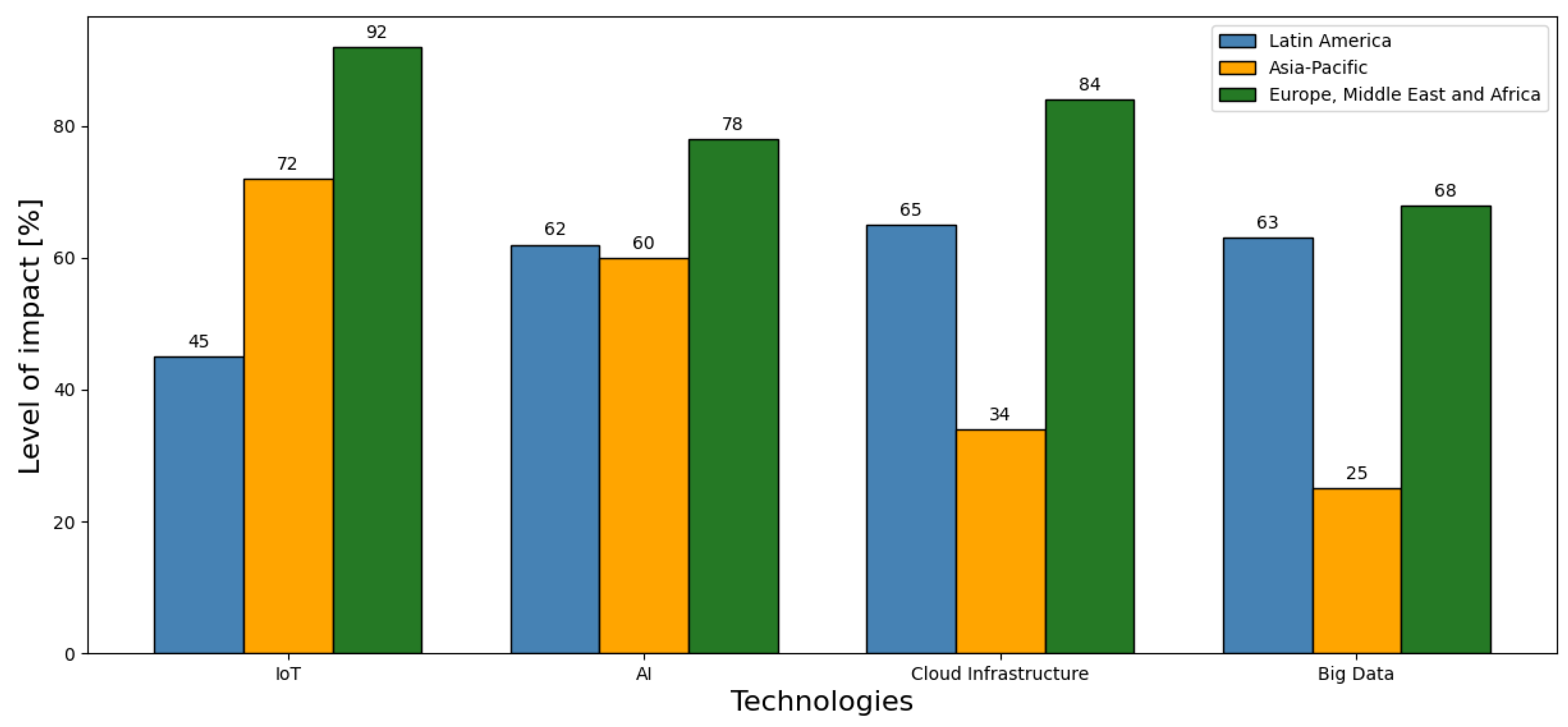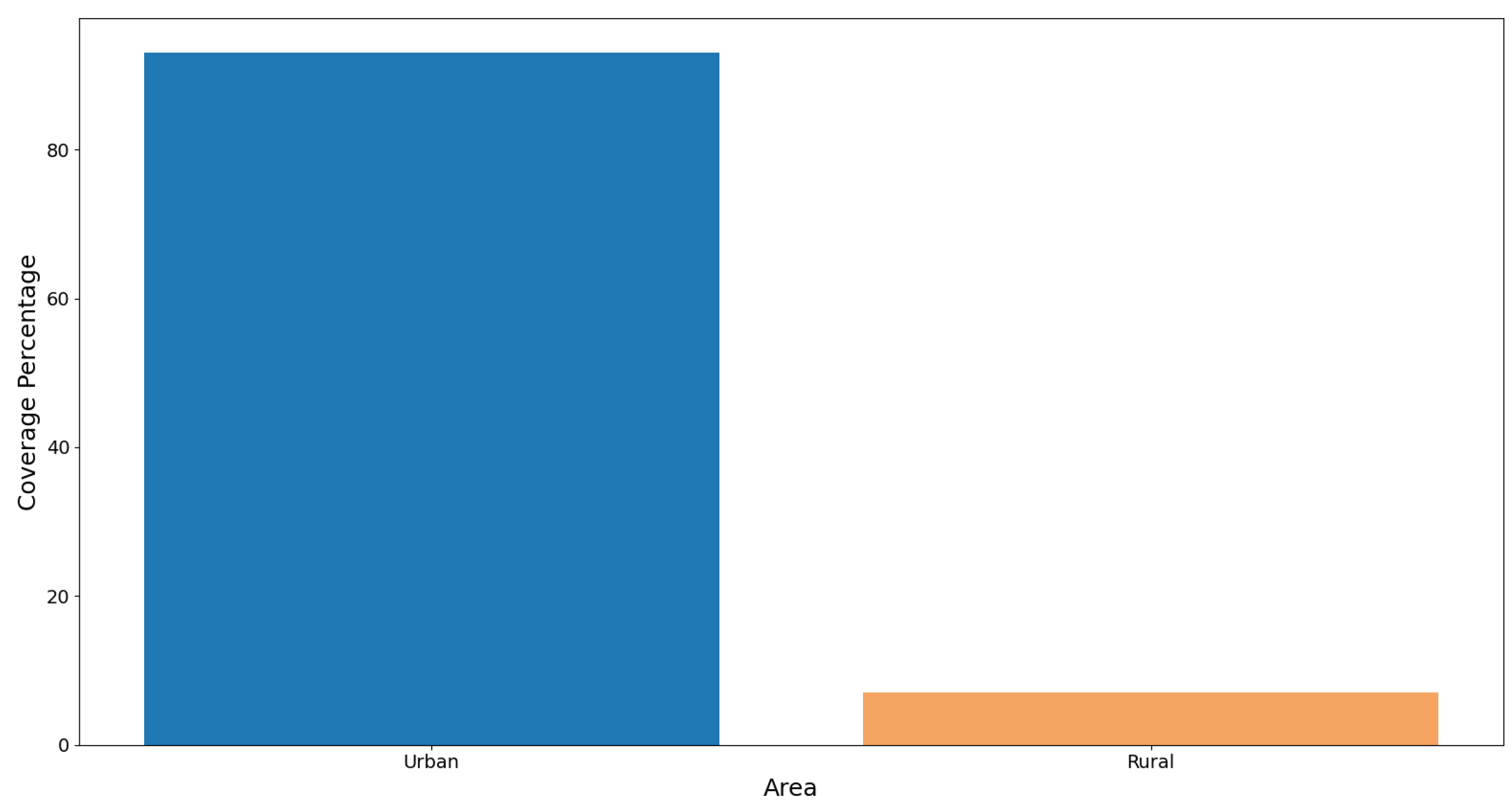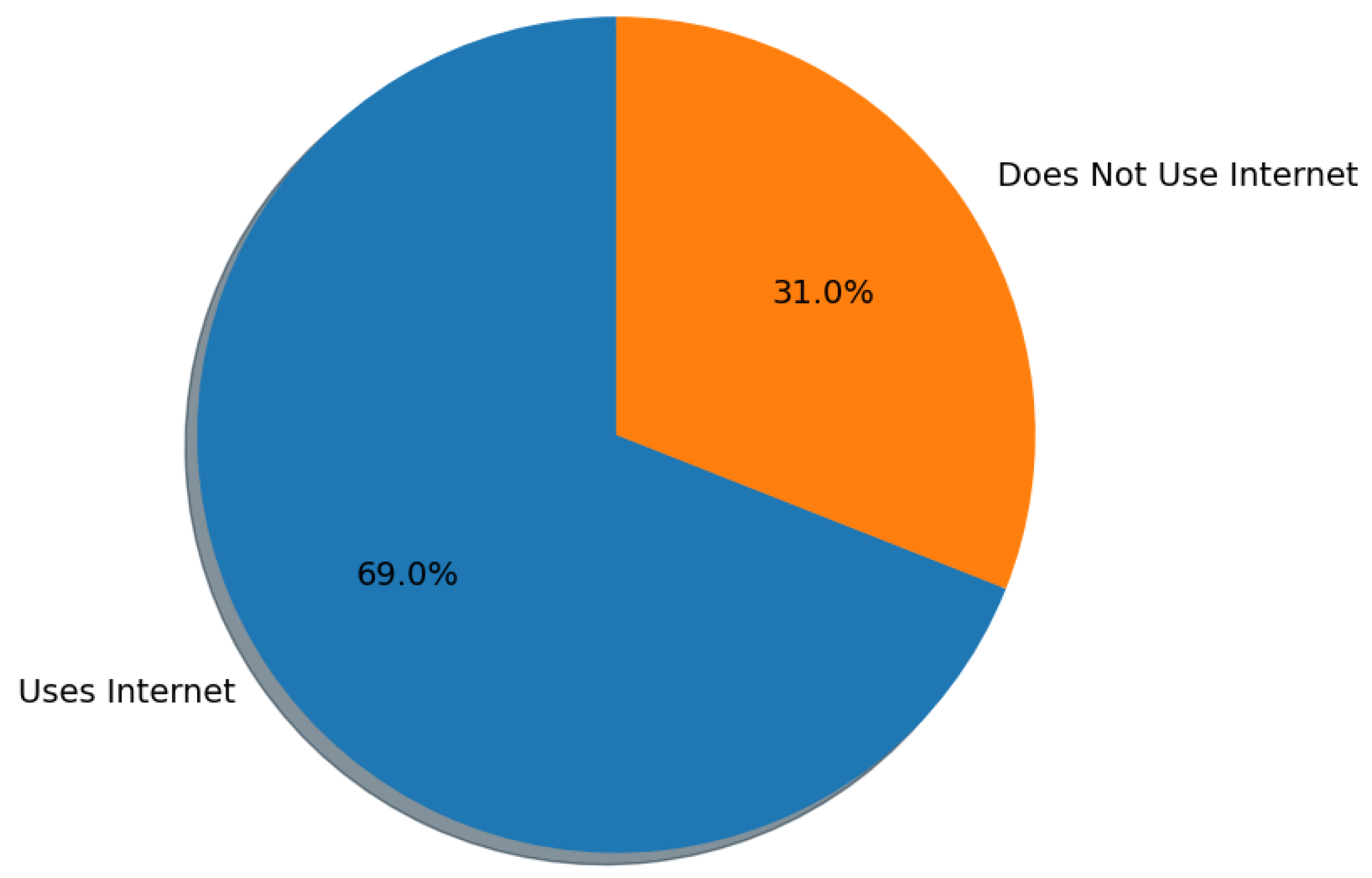Opportunities and Challenges of Industries 4.0 and 5.0 in Latin America
Abstract
1. Introduction
2. Background
Public Policies, Strategic Regulation, Infrastructure, and Information and Communication Technology Training
3. Methodology
4. Results
4.1. Industry 4.0 and 5.0 in LATAM—Indicators
4.1.1. Public Policies and Strategic Vision (20%)
4.1.2. Strategic Regulation (25%)
4.1.3. Infrastructure (40%)
4.1.4. Application and Training (15%)
4.2. Gap Analysis
4.2.1. Fixed Connectivity Gap
- The connectivity gap has increased between LAC and most regions, with LAC lagging particularly behind Europe, North America, and OECD countries.
- The CIS region is the only one that has shown significant improvement, surpassing LAC regarding fixed broadband penetration.
- Africa and the Arab States have shown improvements but not at the same rate as LAC, resulting in a growing connectivity gap.
- Asia and the Pacific have shown a positive trend since 2017, surpassing LAC recently. This analysis highlights the need for specific policies and strategies to improve fixed broadband connectivity in LAC to close existing gaps and promote more equitable technological development.
4.2.2. Mobile Connectivity Gap
- High Accessibility
- Argentina: This country stands out with a significantly high accessibility rate of 54.1%, indicating better access to digital services and infrastructure compared to other countries in the region.
- Moderate Accessibility
- Peru (9.5%) and El Salvador (9.1%): These countries show moderate levels of accessibility, though there is room for improvement.
- Bolivia (8.1%), Colombia (7.7%), and Paraguay (7.1%): These countries also have moderate accessibility levels, slightly lower than Peru and El Salvador, indicating similar challenges in terms of digital infrastructure and accessibility.
- Low Accessibility
- Mexico (5.4%), Brazil (6.2%), and Dominican Republic (6.2%): Despite being relatively large economies, these countries show low accessibility to the digital basket, suggesting inequalities in access to digital services.
- Costa Rica (4.2%), Chile (3.5%), and Uruguay (3.1%): These countries have the lowest accessibility values, indicating a substantial need for investment and improvement in digital infrastructure.
5. Discussion—SWOT Analysis
5.1. Strengths
5.2. Weaknesses
5.3. Opportunity
5.4. Threats
6. Conclusions
- Despite global advances in implementing I4-enabling technologies (IoT, robotics, AI), LA lags far behind. When LA is compared with regions such as Europe and Asia, deep gaps are found in implementing I4-enabling technologies and mobile and fixed broadband connectivity. This is due to inadequate infrastructure, limited investment in R&D, and insufficient public policies to drive technology adoption.
- SMEs, representing a large part of the business structure in LA, face significant difficulties in implementing advanced technologies due to lack of resources, limited digital capabilities, and unequal access to technological infrastructure, especially in rural areas. Therefore, the study highlights the importance of effective collaboration between the public and private sectors to overcome barriers to adopting I4 initiatives that promote training in digital technologies, encourage private investment, and improve strategic regulation, which will be crucial to accelerating the region’s digital transformation.
- The paper highlighted that public policies focused on expanding digital connectivity and increased investment in telecommunications infrastructure are fundamental to closing the technology gap. Countries that have adopted proactive policies have shown improvements in technology adoption, although progress varies significantly between urban and rural areas.
- The analysis of results reveals significant variability in accessibility to the basic digital basket among countries of LAC. This analysis can be useful for policymakers and stakeholders to know more about the current state of digital accessibility and where to focus efforts to bridge the digital divide within the region.
- Public policies implemented by LA governments need a comprehensive approach to strengthening and promoting the capacities of higher education institutions in science, technology, and innovation training. It is essential to develop training and technological assimilation programs driven by government entities that enhance the development of technical skills in rural regions or communities beyond the reach of HEIs. This would facilitate the use of technologies associated with I4 and would give rise to an opportunity for I5 implementation in the region.
Author Contributions
Funding
Institutional Review Board Statement
Informed Consent Statement
Data Availability Statement
Conflicts of Interest
References
- Bartodziej, C. The Concept Industry 4.0: An Empirical Analysis of Technologies and Applications in Production Logistics; BestMasters; Springer: Wiesbaden, Germany, 2016. [Google Scholar]
- Dalenogare, L.S.; Benitez, G.B.; Ayala, N.F.; Frank, A.G. The expected contribution of Industry 4.0 technologies for industrial performance. Int. J. Prod. Econ. 2018, 204, 383–394. [Google Scholar] [CrossRef]
- Ordieres-Meré, J.; Gutierrez, M.; Villalba-Díez, J. Toward the industry 5.0 paradigm: Increasing value creation through the robust integration of humans and machines. Comput. Ind. 2023, 150, 103947. [Google Scholar] [CrossRef]
- A Digital Path for Sustainable Development in Latin America and the Caribbean. 2022, p. 104. Available online: https://repositorio.cepal.org/server/api/core/bitstreams/71eb91ed-b241-41c8-9463-d1eaa3b12932/content (accessed on 20 October 2024).
- Bai, C.; Dallasega, P.; Orzes, G.; Sarkis, J. Industry 4.0 technologies assessment: A sustainability perspective. Int. J. Prod. Econ. 2020, 229, 107776. [Google Scholar] [CrossRef]
- Ladino Fernández, J.M.; Briceño Barrero, D.L.; Rodríguez Rojas, L.A. Industria 4.0: El reto para las pymes manufactureras de Bogotá, Colombia. Rev. Mutis 2022, 12. [Google Scholar] [CrossRef]
- Torres-Samuel, M.; Vásquez, C.L.; Luna, M.; Bucci, N.; Viloria, A.; Crissien, T.; Manosalva, J. Performance of Education and Research in Latin American Countries through Data Envelopment Analysis (DEA). Procedia Comput. Sci. 2020, 170, 1023–1028. [Google Scholar] [CrossRef]
- Hernández, M.R.; Crespo Márquez, A.; López, A.G.; Fernandez, E.C. Hierarchy Definition for Digital Assets. Railway Application. In Proceedings of the 16th WCEAM Proceedings, Seville, Spain, 5–7 October 2022; Crespo Márquez, A., Gómez Fernández, J.F., González-Prida Díaz, V., Amadi-Echendu, J., Eds.; Springer: Cham, Switzerland, 2023; pp. 416–427. [Google Scholar]
- Chen, B.; Wan, J.; Shu, L.; Li, P.; Mukherjee, M.; Yin, B. Smart Factory of Industry 4.0: Key Technologies, Application Case, and Challenges. IEEE Access 2017, 6, 6505–6519. [Google Scholar] [CrossRef]
- Dini, M.; Gligo, N.; Patiño, A. Transformación Digital de las Mipymes: Elementos para el Diseño de políTicas; Naciones Unidas Comisión Económica para América Latina y el Caribe (CEPAL): Santiago, Chile, 2021. [Google Scholar]
- Gómez, K.F.; Titi, C. Facilitating Access to Investor-State Dispute Settlement for Small and Medium-Sized Enterprises: Tracing the Path Forward. Eur. Bus. Law Rev. 2023, 23, 1039–1068. [Google Scholar] [CrossRef]
- Arredondo-Trapero, F.G.; Vázquez-Parra, J.C.; Guerra-Leal, E.M. Information and communication technologies and their impact on competitiveness in Latin America. J. Technol. Manag. Innov. 2020, 15, 43–53. [Google Scholar] [CrossRef]
- Serna Gómez, J.H.; Díaz-Piraquive, F.N.; Muriel-Perea, Y.d.J.; Díaz Peláez, A. Advances, Opportunities, and Challenges in the Digital Transformation of HEIs in Latin America. In Radical Solutions for Digital Transformation in Latin American Universities; Lecture Notes in Educational Technology; Springer: Singapore, 2021; pp. 55–75. [Google Scholar] [CrossRef]
- Celani, G. Shortcut to the Fourth Industrial Revolution: The case of Latin America. Int. J. Archit. Comput. 2020, 18, 320–334. [Google Scholar] [CrossRef]
- Cantor, R.V. La tercera revolución industrial. Univ. Humaníst. 1994, 39. [Google Scholar]
- Lastra Lastra, J.M. Rifkin, Jeremy, La Tercera Revolución Industrial. Boletín Mex. Derecho Comp. 2017, 50, 1457–1462. [Google Scholar] [CrossRef]
- Ominami, C. América Latina y la tercera revolución industrial. Estud. Int. 1986, 19, 407–419. [Google Scholar] [CrossRef][Green Version]
- Scotti, S.L.; García, D. América Latina: Globalización y crecimiento económico. Propuestas 1997, 3, 25–37. Available online: http://repositoriocyt.unlam.edu.ar/handle/123456789/1704 (accessed on 20 October 2024).
- Punina, Á.P.C. Globalización: Revolución industrial y sociedad de la información. Ciencia 2017, 19. [Google Scholar]
- Agote-Garrido, A.; Martín-Gómez, A.; Lama-Ruiz, J.R. Industry 5.0 values. A bibliometric analysis of the new industrial paradigm from the social approach; [valores de la industria 5.0. un análisis bibliométrico del nuevo paradigma industrial desde el enfoque social]. Dyna 2023, 98. [Google Scholar] [CrossRef]
- Ziatdinov, R.; Atteraya, M.; Nabiyev, R. The Fifth Industrial Revolution as a Transformative Step towards Society 5.0. Societies 2024, 14, 19. [Google Scholar] [CrossRef]
- Suharyati, H.; Tarihoran, E.; Khuriyah; Sonny; Nurlaili, L.; Caska, C.; Supardi. Exploring the role of e-learning, digital leadership and digital innovation behavior on schools’ performance during society 5.0 era. Int. J. Data Netw. Sci. 2024, 8, 2527–2538. [Google Scholar] [CrossRef]
- García-Contreras, J.M.; Mendoza-Hernández, L.E. El impacto de la Industria y Sociedad 5.0 en la educación. Uno Sapiens Boletín Científico Esc. Prep. No. 1 2023, 5, 15–18. [Google Scholar]
- Carbajal-Amaya, R. La Universidad del futuro y la Revolución 4.0. Hacia una Universidad innovadora. Análisis prospectivo. Rev. Electrónica Calid. Educ. Super. 2020, 11, 15–26. [Google Scholar] [CrossRef]
- Arici, T.; Kitapci, H. An Investigation of the Impact of the Concept of Society 5.0 On Total Quality Management: The Future of Human-Oriented Technology Studies “Social Quality”. Proc. Eng. Sci. 2021, 3, 81–92. [Google Scholar]
- Zaballos, G.; Iglesias Rodriguez, P.G.D. Informe Anual del Índice de Desarrollo de la Brecha de la Banda Ancha; IDB: Washington, DC, USA, 2023; pp. 5–120. [Google Scholar] [CrossRef]
- Brichetti, J.; Mastronardi, L.; Rivas, M.E.; Serebrisky, T.; Solis, B. La brecha de Infraestructura en América Latina y el Caribe: Estimación de las Necesidades de Inversión Hasta 2030 para Progresar Hacia el Cumplimiento de los Objetivos de Desarrollo Sostenible; IDB: Washington, DC, USA, 2021; pp. 5–140. [Google Scholar] [CrossRef]
- Sarker, I. Machine Learning: Algorithms, Real-World Applications and Research Directions. SN Comput. Sci. 2021, 2, 160. [Google Scholar] [CrossRef] [PubMed]
- Fuller, A.; Fan, Z.; Day, C.; Barlow, C. Digital Twin: Enabling Technologies, Challenges and Open Research. IEEE Access 2020, 8, 108952–108971. [Google Scholar] [CrossRef]
- Mohan, S.; Thirumalai, C.; Srivastava, G. Effective heart disease prediction using hybrid machine learning techniques. IEEE Access 2019, 7, 81542–81554. [Google Scholar] [CrossRef]
- Van Calster, B.; McLernon, D.; Van Smeden, M.; Wynants, L.; Steyerberg, E.; Bossuyt, P.; Collins, G.; MacAskill, P.; Moons, K.; Vickers, A. Calibration: The Achilles heel of predictive analytics. BMC Med. 2019, 17, 230. [Google Scholar] [CrossRef]
- Nguyen, D.C.; Ding, M.; Pathirana, P.N.; Seneviratne, A.; Li, J.; Vincent Poor, H. Federated Learning for Internet of Things: A Comprehensive Survey. IEEE Commun. Surv. Tutorials 2021, 23, 1622–1658. [Google Scholar] [CrossRef]
- Kato, N.; Mao, B.; Tang, F.; Kawamoto, Y.; Liu, J. Ten challenges in advancing machine learning technologies toward 6G. IEEE Wirel. Commun. 2020, 27, 96–103. [Google Scholar] [CrossRef]
- Qadri, Y.A.; Nauman, A.; Zikria, Y.B.; Vasilakos, A.V.; Kim, S.W. The Future of Healthcare Internet of Things: A Survey of Emerging Technologies. IEEE Commun. Surv. Tutor. 2020, 22, 1121–1167. [Google Scholar] [CrossRef]
- Nguyen, G.; Dlugolinsky, S.; Bobák, M.; Tran, V.; López García, Á.; Heredia, I.; Malík, P.; Hluchý, L. Machine Learning and Deep Learning frameworks and libraries for large-scale data mining: A survey. Artif. Intell. Rev. 2019, 52, 77–124. [Google Scholar] [CrossRef]
- Salas, J.; Patterson, G.; De Barros Vidal, F. A Systematic Mapping of Artificial Intelligence Solutions for Sustainability Challenges in Latin America and the Caribbean. IEEE Lat. Am. Trans. 2022, 20, 2312–2329. [Google Scholar] [CrossRef]
- Wang, C.; Tan, X.; Tor, S.; Lim, C. Machine learning in additive manufacturing: State-of-the-art and perspectives. Addit. Manuf. 2020, 36, 101538. [Google Scholar] [CrossRef]
- Bzdok, D.; Meyer-Lindenberg, A. Machine Learning for Precision Psychiatry: Opportunities and Challenges. Biol. Psychiatry Cogn. Neurosci. Neuroimaging 2018, 3, 223–230. [Google Scholar] [CrossRef] [PubMed]
- Ardolino, M.; Rapaccini, M.; Saccani, N.; Gaiardelli, P.; Crespi, G.; Ruggeri, C. The role of digital technologies for the service transformation of industrial companies. Int. J. Prod. Res. 2018, 56, 2116–2132. [Google Scholar] [CrossRef]
- Diez-Olivan, A.; Del Ser, J.; Galar, D.; Sierra, B. Data fusion and machine learning for industrial prognosis: Trends and perspectives towards Industry 4.0. Inf. Fusion 2019, 50, 92–111. [Google Scholar] [CrossRef]
- Valencia-Moreno, J.; Gonzalez-Fraga, J.; Febles-Rodriguez, J.; Gutierrez-Lopez, E. Review of Intelligent Algorithms for Breast Cancer Control: A Latin America Perspective. IEEE Lat. Am. Trans. 2023, 21, 226–241. [Google Scholar] [CrossRef]
- Cano, S. Women Teaching Engineering via STEM in Latin America. In Proceedings of the 2020 X International Conference on Virtual Campus (JICV), Tetouan, Morocco, 3–5 December 2020; Institute of Electrical and Electronics Engineers Inc.: Piscataway, NJ, USA, 2020. [Google Scholar] [CrossRef]
- Sun, Y.; Peng, M.; Zhou, Y.; Huang, Y.; Mao, S. Application of Machine Learning in Wireless Networks: Key Techniques and Open Issues. IEEE Commun. Surv. Tutorials 2019, 21, 302–3108. [Google Scholar] [CrossRef]
- De Caigny, A.; Coussement, K.; De Bock, K.W. A new hybrid classification algorithm for customer churn prediction based on logistic regression and decision trees. Eur. J. Oper. Res. 2018, 269, 760–772. [Google Scholar] [CrossRef]
- Sun, A.Y.; Scanlon, B.R. How can Big Data and machine learning benefit environment and water management: A survey of methods, applications, and future directions. Environ. Res. Lett. 2019, 14, 073001. [Google Scholar] [CrossRef]
- Otchere, D.; Arbi Ganat, T.; Gholami, R.; Ridha, S. Application of supervised machine learning paradigms in the prediction of petroleum reservoir properties: Comparative analysis of ANN and SVM models. J. Pet. Sci. Eng. 2021, 200, 108182. [Google Scholar] [CrossRef]
- GSMA Latin America. Brechas de Conectividad en América Latina; Technical Report; GSMA Latin America: Buenos Aires, Argentina, 2023. [Google Scholar]
- Organización de las Naciones Unidas. Superar las Trampas del Desarrollo de América Latina y el Caribe en la era Digital: El Potencial Transformador de las Tecnologías Digitales y la Inteligencia Artificial; Organización de las Naciones Unidas: New York, NY, USA, 2024. [Google Scholar]
- CEPAL. Estadísticas e Indicadores—CEPALSTAT Bases de Datos y Publicaciones Estadísticas; CEPAL: Santiago, Chile, 2024. [Google Scholar]

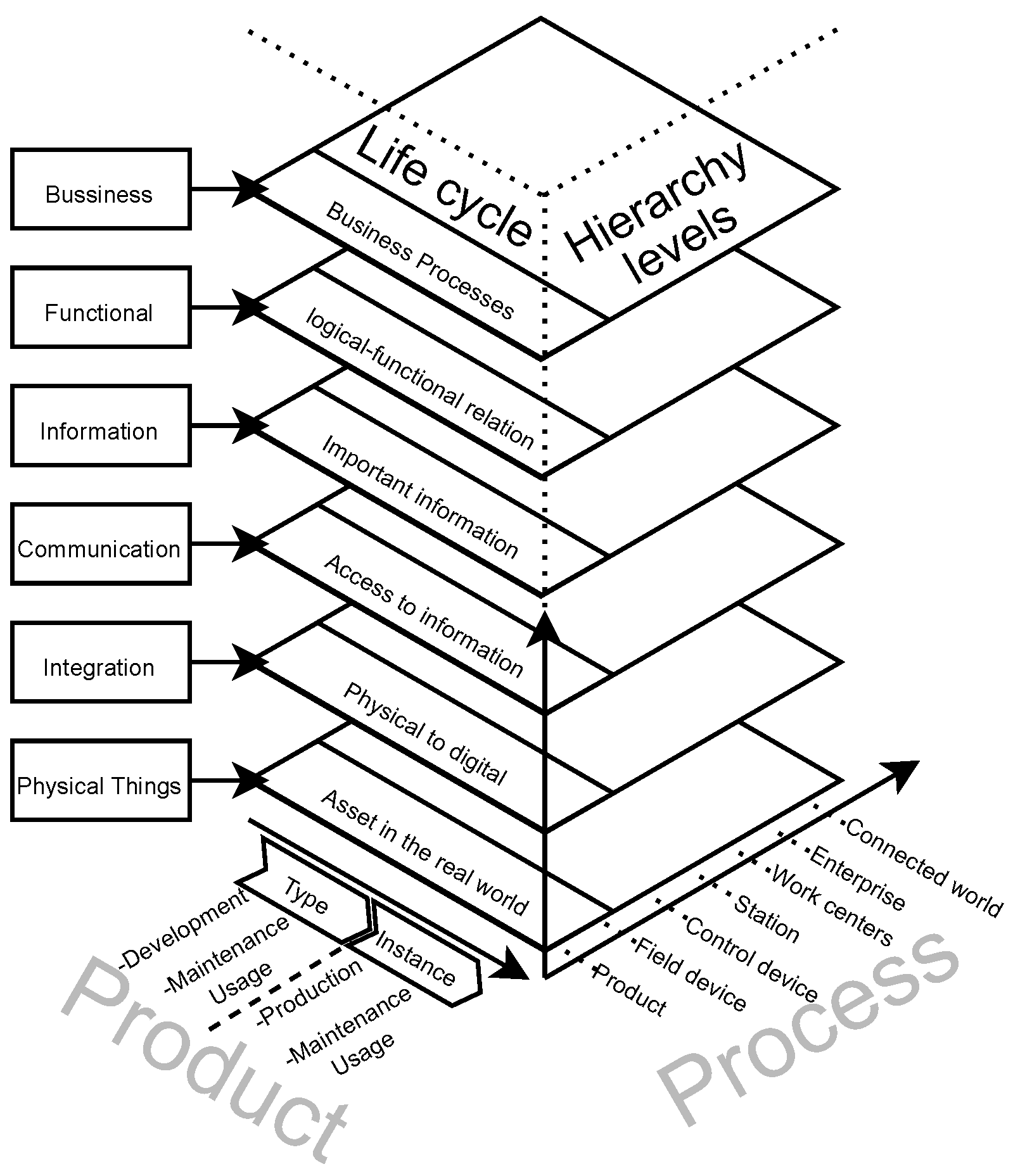
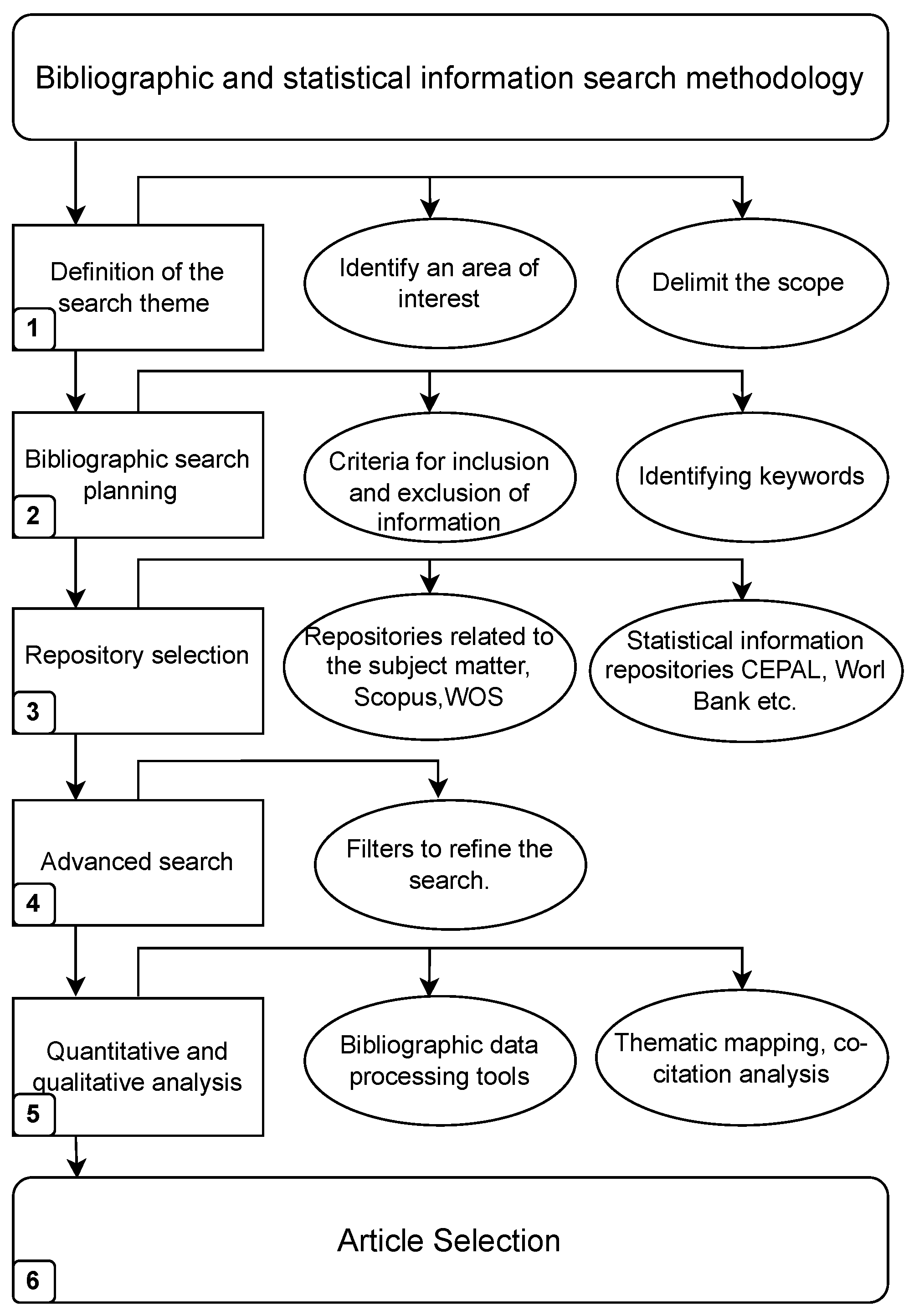
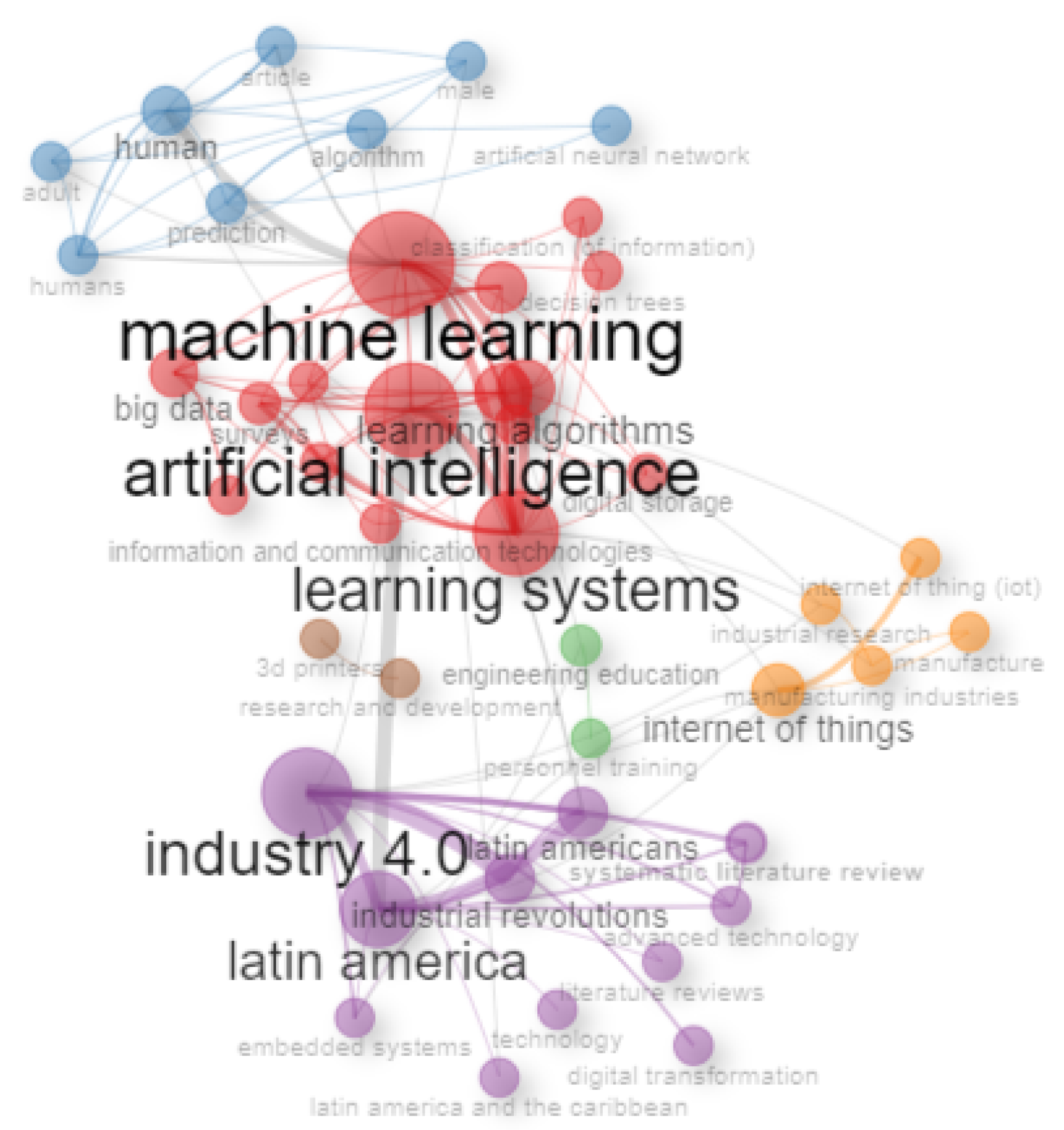
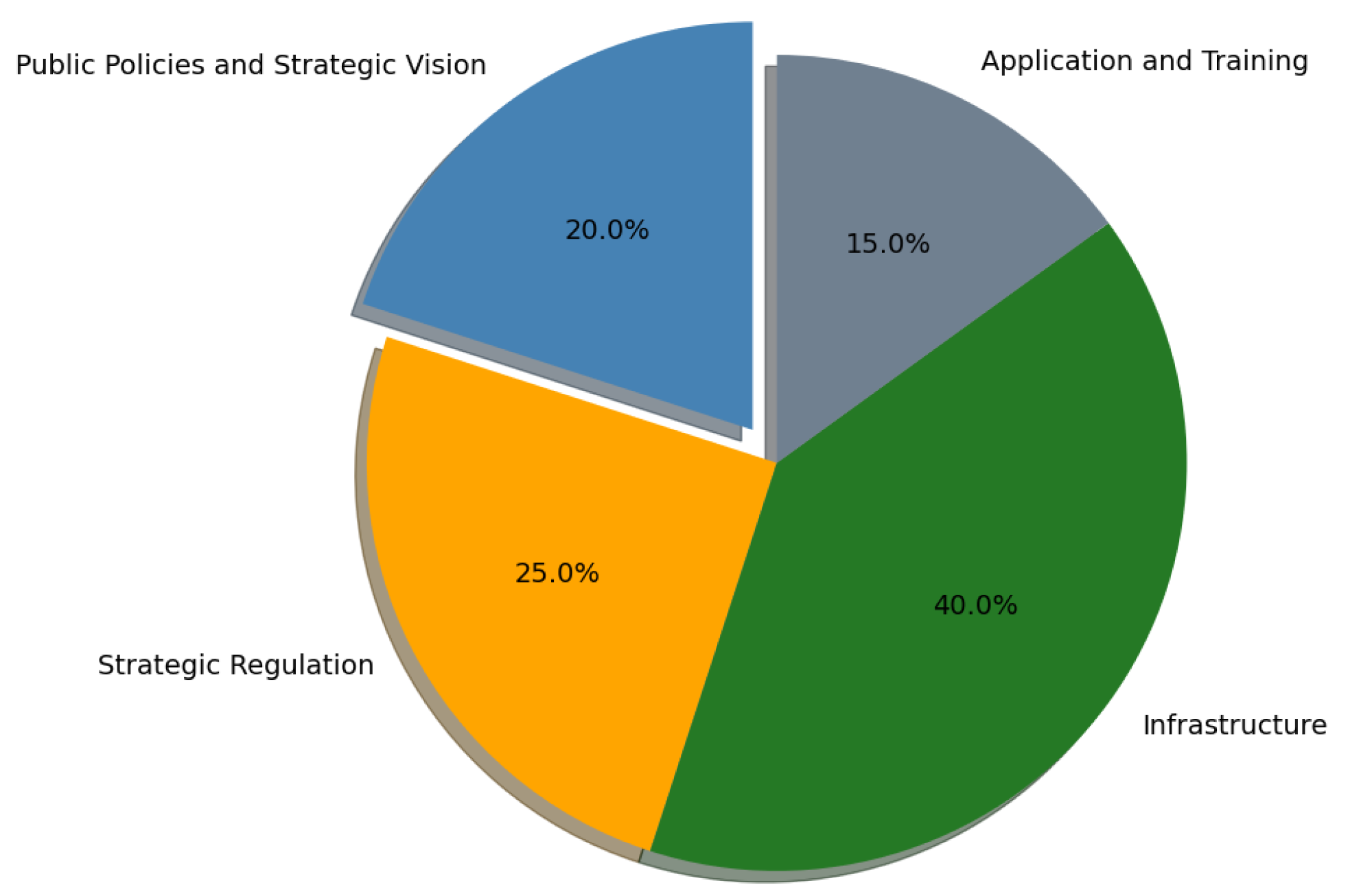
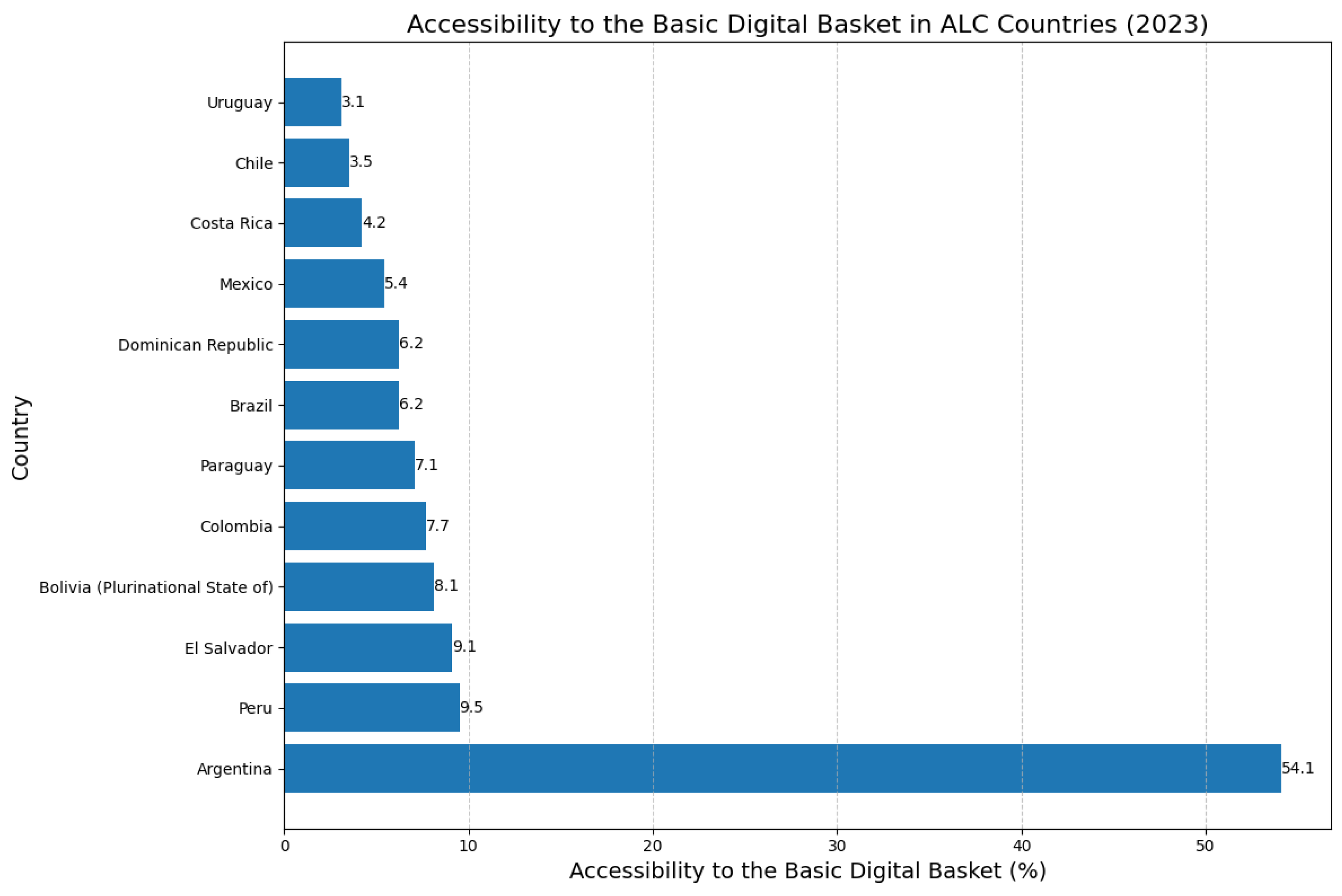
| Public policies: They describe the importance given to ICT development policies through laws and policies that foster their expansion and competition, driving technological growth. | Strategic regulation: They verify the development of strategic regulations by evaluating effectiveness indicators, such as the degree of concentration and competition in the fixed and mobile broadband market. |
| Infrastructure: It measures the state of digital infrastructures and the development of public–private agreements, the number of lines of different services, or investment in telecommunications. | Training: It measures the level of ICT skills through statistics on the level of education and ICT adoption in industry and households. |
| Paper, Year | SDGs | AI | I4 | ML | LA | Tech | Obs | MC |
|---|---|---|---|---|---|---|---|---|
| [28] Sarker, 2021 | 8,9 | x | x | x | x | ML | ||
| [29] Fuller, 2020 | 9,12 | x | x | I4 | ||||
| [30] Mohan, 2019 | 3,9,17 | x | x | x | AI | |||
| [7] Torres-Samuel, 2020 | 9,17 | x | x | x | LA | |||
| [31] Van Calster, 2019 | 3,9 | x | ML | |||||
| [32] Nguyen, 2021 | 9 | x | AI | |||||
| [33] Kato, 2020 | 4,9 | x | x | LA | ||||
| [34] Qadri, 2020 | 3,9 | x | AI | |||||
| [35] Nguyen, 2019 | 9 | x | x | x | AI | |||
| [36] Salas, 2022 | 3,8,13,17 | x | x | x | LA | |||
| [37] Wang, 2020 | 9 | x | x | x | I4 | |||
| [38] Bzdok D, 2018 | 3,9 | x | ML | |||||
| [39] Ardolino, 2018 | 9 | x | AI | |||||
| [40] Diez-Olivan, 2019 | 9 | x | x | I4 | ||||
| [41] Valencia-Moreno, 2023 | 3,17 | x | x | LA | ||||
| [42] Cano, 2020 | 5,9,17 | x | x | Tech | ||||
| [43] Sun, 2019 | 9 | x | x | ML | ||||
| [44] De Caigny, 2018 | 9 | x | x | AI | ||||
| [45] Sun, 2019 | 6 | x | x | AI | ||||
| [46] Otchere, 2021 | 7 | x | x | ML | ||||
| Clusters on the | ||||||||
| Co-occurrence map | ||||||||
| Country | Population (In Millions of People) | Population Density | %RBB Adoption | % MB Adoption | Capex MB +10% (MUSD) | Capex RBB +10% (MUSD) | Increase in Employment (In Thousands) |
|---|---|---|---|---|---|---|---|
| Argentina | 44.5 | 16.26 | 23.10 | 68.9 | 261.54 | 2244.74 | 305.8 |
| Bolivia | 11.4 | 10.48 | 9.3 | 86.7 | 66.73 | 635.28 | 78.03 |
| Brazil | 209.5 | 25.06 | 19.4 | 95.9 | 1231.26 | 9431 | 1439.63 |
| Chile | 18.71 | 25.19 | 22 | 110.8 | 143.12 | 842.06 | 128.7 |
| Colombia | 49.65 | 44.75 | 16.4 | 71.4 | 291.84 | 1874.42 | 341.2 |
| Costa Rica | 5 | 97.91 | 20.5 | 87.3 | 29.39 | 139.66 | 34.4 |
| Ecuador | 17.1 | 68.79 | 13.9 | 56.7 | 100.42 | 552.88 | 117.4 |
| El Salvador | 6.42 | 309.88 | 9.7 | 77 | 37.74 | 86.60 | 44.1 |
| Guatemala | 17.2 | 160.95 | 3.5 | 17.1 | 101.38 | 374.31 | 118.5 |
| Honduras | 9.6 | 85.69 | 4.1 | 47.6 | 56.36 | 283.86 | 65.9 |
| Mexico | 126.2 | 64.91 | 18.4 | 82.5 | 741.75 | 4175.5 | 867.3 |
| Nicaragua | 6.5 | 53.73 | 4.4 | 55.2 | 38 | 229.27 | 44.4 |
| Panama | 4.2 | 56.19 | 13.2 | 78.4 | 24.55 | 145.77 | 28.7 |
| Paraguay | 7 | 17.51 | 10.5 | 69.7 | 40.89 | 344.47 | 47.8 |
| Peru | 32 | 24.99 | 9.1 | 80.6 | 188.03 | 1441.34 | 219.9 |
| Dominican Republic | 10.6 | 219.98 | 9.8 | 66.7 | 62.47 | 189 | 73 |
| Uruguay | 3.4 | 19.71 | 32.3 | 109.1 | 20.27 | 165.7 | 23.7 |
| Venezuela | 28.9 | 32.73 | 9.1 | 44.3 | 169.7 | 1203.2 | 198.4 |
| Country | Capex MB OCDE (MUSD) | Capex RBB OCDE (MUSD) | Increase in Employment (OCDE) | % Rural Investments |
|---|---|---|---|---|
| Argentina | 1759.1 | 3161.1 | 1243.72 | 20.69% |
| Bolivia | 330.06 | 1771.17 | 301.73 | 56.25% |
| Brazil | 4957 | 16,768.35 | 4177.8 | 30.95% |
| Chile | 279.2 | 1278.24 | 260.92 | 29.03% |
| Colombia | 1889.92 | 3895 | 1459.4 | 41.30% |
| Costa Rica | 143.58 | 232.95 | 112.6 | 42.86% |
| Ecuador | 797.9 | 1287.1 | 603.17 | 62.79% |
| El Salvador | 223.28 | 237,97 | 191.16 | 52.60% |
| Guatemala | 1207 | 1260.67 | 905.29 | 74.24% |
| Honduras | 499 | 939 | 400.76 | 68.48% |
| Mexico | 3980.21 | 7841.56 | 3141.27 | 42.86% |
| Nicaragua | 307.68 | 751.55 | 252.71 | 67.58% |
| Panama | 141.81 | 349.56 | 117.23 | 58.54% |
| Paraguay | 271.74 | 919 | 222.64 | 64.77% |
| Peru | 1044.71 | 4047.412 | 919.43 | 45.83% |
| Dominican Republic | 433.89 | 517.47 | 353.65 | 39.71% |
| Uruguay | 54.86 | 80.86 | 37.86 | 13.67% |
| Venezuela | 1558.85 | 3378.53 | 1189.9 | 34.62% |
Disclaimer/Publisher’s Note: The statements, opinions and data contained in all publications are solely those of the individual author(s) and contributor(s) and not of MDPI and/or the editor(s). MDPI and/or the editor(s) disclaim responsibility for any injury to people or property resulting from any ideas, methods, instructions or products referred to in the content. |
© 2025 by the authors. Licensee MDPI, Basel, Switzerland. This article is an open access article distributed under the terms and conditions of the Creative Commons Attribution (CC BY) license (https://creativecommons.org/licenses/by/4.0/).
Share and Cite
Rueda-Carvajal, G.D.; Tobar-Rosero, O.A.; Sánchez-Zuluaga, G.J.; Candelo-Becerra, J.E.; Flórez-Celis, H.A. Opportunities and Challenges of Industries 4.0 and 5.0 in Latin America. Sci 2025, 7, 68. https://doi.org/10.3390/sci7020068
Rueda-Carvajal GD, Tobar-Rosero OA, Sánchez-Zuluaga GJ, Candelo-Becerra JE, Flórez-Celis HA. Opportunities and Challenges of Industries 4.0 and 5.0 in Latin America. Sci. 2025; 7(2):68. https://doi.org/10.3390/sci7020068
Chicago/Turabian StyleRueda-Carvajal, Germán D., Oscar A. Tobar-Rosero, Gabriel J. Sánchez-Zuluaga, John E. Candelo-Becerra, and Héctor Andrés Flórez-Celis. 2025. "Opportunities and Challenges of Industries 4.0 and 5.0 in Latin America" Sci 7, no. 2: 68. https://doi.org/10.3390/sci7020068
APA StyleRueda-Carvajal, G. D., Tobar-Rosero, O. A., Sánchez-Zuluaga, G. J., Candelo-Becerra, J. E., & Flórez-Celis, H. A. (2025). Opportunities and Challenges of Industries 4.0 and 5.0 in Latin America. Sci, 7(2), 68. https://doi.org/10.3390/sci7020068







